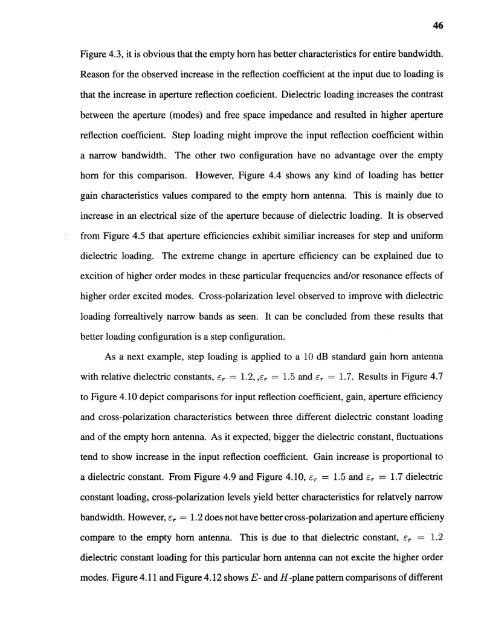Variable permittivity dielectric material loaded stepped-horn antenna
Variable permittivity dielectric material loaded stepped-horn antenna
Variable permittivity dielectric material loaded stepped-horn antenna
You also want an ePaper? Increase the reach of your titles
YUMPU automatically turns print PDFs into web optimized ePapers that Google loves.
46Figure 4.3, it is obvious that the empty <strong>horn</strong> has better characteristics for entire bandwidth.Reason for the observed increase in the reflection coefficient at the input due to loading isthat the increase in aperture reflection coeficient. Dielectric loading increases the contrastbetween the aperture (modes) and free space impedance and resulted in higher aperturereflection coefficient. Step loading might improve the input reflection coefficient withina narrow bandwidth. The other two configuration have no advantage over the empty<strong>horn</strong> for this comparison. However, Figure 4.4 shows any kind of loading has bettergain characteristics values compared to the empty <strong>horn</strong> <strong>antenna</strong>. This is mainly due toincrease in an electrical size of the aperture because of <strong>dielectric</strong> loading. It is observedfrom Figure 4.5 that aperture efficiencies exhibit similiar increases for step and uniform<strong>dielectric</strong> loading. The extreme change in aperture efficiency can be explained due toexcition of higher order modes in these particular frequencies and/or resonance effects ofhigher order excited modes. Cross-polarization level observed to improve with <strong>dielectric</strong>loading forrealtively narrow bands as seen. It can be concluded from these results thatbetter loading configuration is a step configuration.As a next example, step loading is applied to a 10 dB standard gain <strong>horn</strong> <strong>antenna</strong>with relative <strong>dielectric</strong> constants, εr = 1.2, ,εr = 1.5 and εr = 1.7. Results in Figure 4.7to Figure 4.10 depict comparisons for input reflection coefficient, gain, aperture efficiencyand cross-polarization characteristics between three different <strong>dielectric</strong> constant loadingand of the empty <strong>horn</strong> <strong>antenna</strong>. As it expected, bigger the <strong>dielectric</strong> constant, fluctuationstend to show increase in the input reflection coefficient. Gain increase is proportional toa <strong>dielectric</strong> constant. From Figure 4.9 and Figure 4.10, εr = 1.5 and εr = 1.7 <strong>dielectric</strong>constant loading, cross-polarization levels yield better characteristics for relatvely narrowbandwidth. However, εr = 1.2 does not have better cross-polarization and aperture efficienycompare to the empty <strong>horn</strong> <strong>antenna</strong>. This is due to that <strong>dielectric</strong> constant, εr = 1.2<strong>dielectric</strong> constant loading for this particular <strong>horn</strong> <strong>antenna</strong> can not excite the higher ordermodes. Figure 4.11 and Figure 4.12 shows E- and H-plane pattern comparisons of different
















